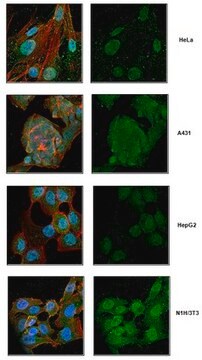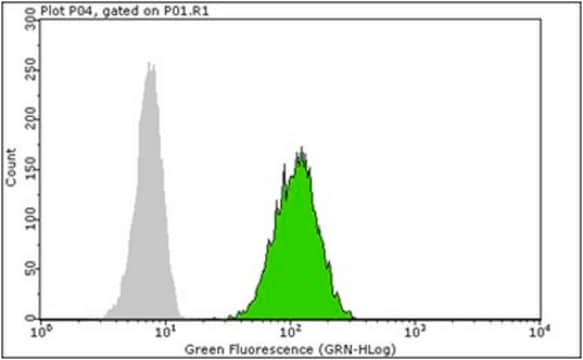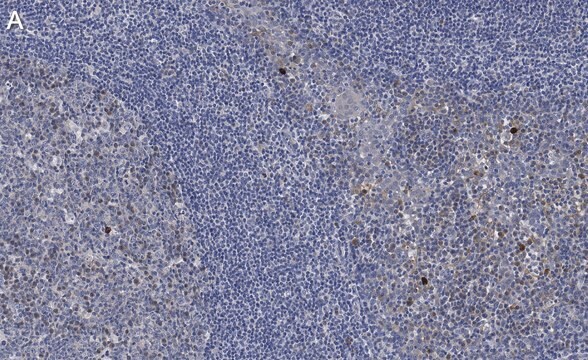MABC592
Anti-TRP1/TYRP1 Antibody, clone TA99, Azide Free
clone TA99, 1 mg/mL, from mouse
Synonim(y):
5,6-dihydroxyindole-2-carboxylic acid oxidase, DHICA oxidase, Catalase B, Glycoprotein 75, Melanoma antigen gp75, Tyrosinase-related protein 1, TRP, TRP-1, TRP1
Wybierz wielkość
Wybierz wielkość
About This Item
Polecane produkty
pochodzenie biologiczne
mouse
Poziom jakości
forma przeciwciała
purified immunoglobulin
rodzaj przeciwciała
primary antibodies
klon
TA99, monoclonal
reaktywność gatunkowa
human, mouse
stężenie
1 mg/mL
metody
blocking: suitable (interfering antibodies)
flow cytometry: suitable
immunohistochemistry: suitable
immunoprecipitation (IP): suitable
western blot: suitable
izotyp
IgG2aκ
numer dostępu NCBI
numer dostępu UniProt
Warunki transportu
wet ice
docelowa modyfikacja potranslacyjna
unmodified
informacje o genach
human ... TYRP1(7306)
Powiązane kategorie
Opis ogólny
Immunogen
Zastosowanie
Blocking of Interferring Antibodies Analysis: A representative lot from an independent laboratory suppressed the growth of subcutaneous B16 tumors (Patel, D., et al. (2008). Anticancer Res. 28(5A):2679-2686.).
Activity Assay Analysis: A representative lot from an independent laboratory improves anti-tumor efficacy by augmenting systemic CD8+T cell responses to tumor cells (Saenger, Y. M., et al. (2008). Cancer Res. 68(23):9884-9891.).
Immunoprecipiptation Analysis: A representative lot from an independent laboratory immunoprecipiated TRP1/TYRP1 from B16 cell lysate (Srinivasan, R., et al. (2002). Cancer Immun. 19(2):8.).
Apoptosis & Cancer
Apoptosis - Additional
Jakość
Western Blotting Analysis: 1 µg/mL of this antibody detected TRP1/TYRP1 in 10 µg of mouse skin tissue lysate.
Opis wartości docelowych
Postać fizyczna
Przechowywanie i stabilność
Handling Recommendations: Upon receipt and prior to removing the cap, centrifuge the vial and gently mix the solution. Aliquot into microcentrifuge tubes and store at -20°C. Avoid repeated freeze/thaw cycles, which may damage IgG and affect product performance.
Oświadczenie o zrzeczeniu się odpowiedzialności
Nie możesz znaleźć właściwego produktu?
Wypróbuj nasz Narzędzie selektora produktów.
Kod klasy składowania
12 - Non Combustible Liquids
Klasa zagrożenia wodnego (WGK)
WGK 2
Temperatura zapłonu (°F)
Not applicable
Temperatura zapłonu (°C)
Not applicable
Certyfikaty analizy (CoA)
Poszukaj Certyfikaty analizy (CoA), wpisując numer partii/serii produktów. Numery serii i partii można znaleźć na etykiecie produktu po słowach „seria” lub „partia”.
Masz już ten produkt?
Dokumenty związane z niedawno zakupionymi produktami zostały zamieszczone w Bibliotece dokumentów.
Active Filters
Nasz zespół naukowców ma doświadczenie we wszystkich obszarach badań, w tym w naukach przyrodniczych, materiałoznawstwie, syntezie chemicznej, chromatografii, analityce i wielu innych dziedzinach.
Skontaktuj się z zespołem ds. pomocy technicznej








